 Economy
Economy

 |
| The first batch of LNG sent from South to North by train in Việt Nam. Gas and LNG will become crucial for ensuring the country’s energy security and supporting sustainable economic growth. -- VNS Photo Hồng Minh |
HCM CITY – Việt Nam needs to develop a holistic strategy to ensure sustainable, reliable and cost-competitive gas supply, experts have said.
At a seminar titled “LNG: Fuelling Việt Nam’s Sustainable Growth Industry” organised by global energy market insight provider, Wood Mackenzie, and Malaysia's Petroliam Nasional Berhad (Petronas) in HCM City on September 5, pointing out that Việt Nam’s gas demand is increasing due to the burgeoning need for power for economic growth, they said the country would need to rely on liquefied natural gas (LNG) imports since domestic supply could not meet demand.
Its economic growth depends on strategic investments in gas infrastructure, LNG contracts and essential policy reforms as demand will grow at an average of 12 per cent annually, potentially tripling by the mid-2030s, the seminar heard.
A Wood Mackenzie report indicated that coal has a significant share in Việt Nam's energy mix, with its consumption being seven times higher than gas in 2020.
But gas consumption is projected to increase from eight million tonnes of oil equivalent (Mtoe) in 2020 to 20 Mtoe by 2035.
By 2050 the share of coal is anticipated to decrease by 7 Mtoe, while that of gas is expected to reach 32 Mtoe.
Gas is expected to play a crucial role in the nation's energy transition journey.
Joshua Ngu, vice chairman, Asia Pacific, Wood Mackenzie, said: “Gas will serve as a key fuel in the energy transition journey in the long term. Gas demand in the power sector will continue to dominate. The gas share in total power generation will reach 14 per cent by 2030.”
Gas-fired power is becoming increasingly necessary to prevent potential electricity shortages in the near term, he said.
“As coal generation levels off in the mid-term and renewable energy continues to face challenges with intermittency and grid constrains, gas and LNG will become crucial for ensuring the country’s energy security and supporting sustainable economic growth.”
While gas demand is forecast to increase, Việt Nam faces challenges in domestic production.
Its gas fields, primarily located in the southeast, are maturing, leading to a 25 per cent decline in supply over the past five years.
However, recent developments such as the Final Investment Decision for Block B in the Malay Basin are expected to boost production by 0.4 billion cubic feet a day, equivalent to 11.3 million cubic metres, by 2030.
Furthermore, pipeline gas from Indonesia’s Tuna PSC in the Natuna Sea is expected to flow to Việt Nam by 2030.
The Wood Mackenzie report said Việt Nam is fully exposed to the spot LNG market and has yet to sign long-term LNG contracts.
Raghav Mathur, the company’s principal research analyst, gas and LNG, said: “The lack of contracted LNG supply, coupled with dwindling domestic resources, increases Việt Nam’s exposure to potential price volatility and raises the risk of future backouts and gas rationing.
“The misalignments in LNG-fired electricity prices, power purchase agreements and construction delays in LNG-to-power projects have been substantial obstacles to LNG contracting in Việt Nam.”
But developing new gas infrastructure would ease concerns about gas shortages.
The country’s main pipeline network is concentrated in the southern region, home to economic hub HCM City.
Two LNG regasification facilities have been built in the south, with the Thị Vải LNG terminal already operational and the Hải Linh terminal expected to go on stream in September 2024.
Several more regasification terminals are in the feasibility stage and will be operational by the early 2030s.
Yulin Li, research associate, gas and LNG, at Wood Mackenzie, said: “The Vietnamese Government’s approval of the Power Development Plan 8 in May 2023 underscores the importance of LNG-to-power projects, targeting an additional 22.4 GW of LNG-fired capacity by 2030.
“However, for Việt Nam to fully realise the potential of gas and LNG, there is a need for a dedicated energy system to focus on energy policy and regulation.” – VNS